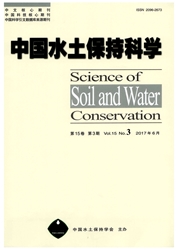

 中文摘要:
中文摘要:
以侵蚀环境不同退耕撂荒年限样地为研究对象,采用空间代替时间序列的方法调查植物群落特征,分析植物恢复过程。结果表明:植物群落覆盖度和地上生物量随退耕撂荒年限的增加,恢复演替的推进逐渐增大;群落物种多样性指数与撂荒年限呈正相关,而群落优势度指数与撂荒年限呈负相关;物种多样性指数能极好地反映群落物种丰富度,并能客观表达物种的动态变化,其演变呈升—降—升的趋势,退耕撂荒3、10和25 a左右时为物种多样性指数的高峰。植物群落结构稳定性与物种多样性、群落生物量、覆盖度和优势度关系密切,随着退耕撂荒地植被恢复演替的进展,植被结构稳定性呈阶梯式增强,从而为侵蚀环境生态恢复提供了基础保障。
 英文摘要:
英文摘要:
In order to understand the characteristics and dynamics of plant community on abandoned arable land on Loess Plateau,11 abandoned arable lands with different ages were studied systematically through the approach of substituting the temporal serial with spatial serial.The results showed that with the increased in the number of years of land abandonment,the plant community's coverage and above-ground biomass increased gradually.There is a positive correlation between the species diversity index and abandoned age which can accurately reflect species richness and dynamic change objectively,but correlate with community dominance negatively.The evolution tendency which rise at the beginning,then drop and also rise can reach the peak of the species diversity index after land abandonment for about 3,10 and 25 years.The stability of plant community structure has a close relation with biomass,diversity,coverage and dominance,which strengthen stepedly with the progress of restorative succession and provide a foundation for ecological restoration under erosion environment.
 同期刊论文项目
同期刊论文项目
 同项目期刊论文
同项目期刊论文
 Effects of long-term fertilization and mulch on soil fertility in contour hedgerow systems: A case s
Effects of long-term fertilization and mulch on soil fertility in contour hedgerow systems: A case s The effect of land cover/vegetation on soil water dynamic in the hilly area of the loess plateau, Ch
The effect of land cover/vegetation on soil water dynamic in the hilly area of the loess plateau, Ch The effect of land uses and rainfall regimes on runoff and soil erosion in the semi-arid loess hilly
The effect of land uses and rainfall regimes on runoff and soil erosion in the semi-arid loess hilly Secondary succession and its effects on soil moisture and nutrition in abandoned old-fields of hilly
Secondary succession and its effects on soil moisture and nutrition in abandoned old-fields of hilly 期刊信息
期刊信息
